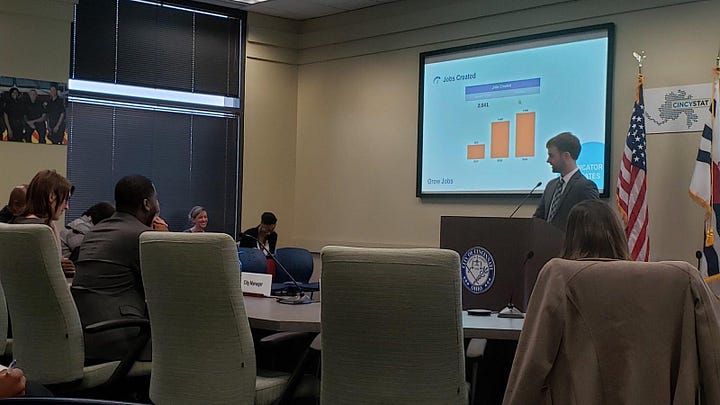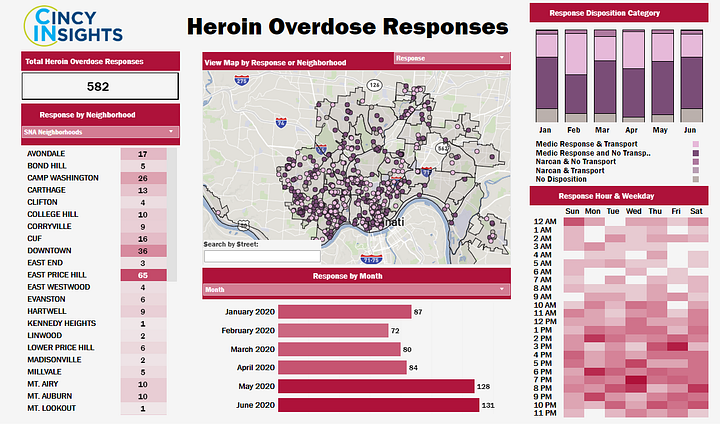Cincinnati, Ohio, USA
Cincinnati Surges Forward.
Project Type:
Community Engagement, Cross-Sector, Economic Development, Equity, Finance, Health & Wellness, High-Performing Government, Infrastructure, Public Safety
2023 Gold Certification
Cincinnati’s Emergency Communications Center historically has had three dispatchable tools for handling incoming 911 calls: the police department, the fire department and parking enforcement. But when calls involved mental health, the unhoused, and poverty crises, none of these tools clearly aligned with the need. In 2022, the City piloted a new public safety resource – Alternative Response to Crisis (ARC) – sending a Behavioral Health Technician and paramedic to low-risk calls rather than police. The City tracked the program’s progress on an ARC Dashboard. It found that over the first 12 months of ARC, the City was able to save more than 3,000 hours of police officer time and freed up resources that could then be directed towards more high-risk calls. Based on the data, the City expanded ARC’s capacity in the FY 2024-2025 Biennial Budget.
2020 Silver Certification
Office of Performance and Data Analytics (OPDA) helps deliver better, faster, and smarter services to city residents by working across departments to measure performance, evaluate success, and identify areas for improvement.
Create hundreds of dashboard to track performance and provide both residents and internal city staff high-level, real-time information about a variety of city services.
Used data to address systemic issues in their emergency response system, increasing the number of 911 calls they answered in less than 10 seconds from 40 percent to over 90 percent in just a few months.
Implementing City Services
Set along the gently curving Ohio River, which forms the border between Ohio and Kentucky, Cincinnati is an unassuming city. At times overshadowed, lacking the more national profile of nearby cities like Cleveland or Pittsburgh, the Queen City is the home of two Fortune 50 companies, two major universities, three professional sports teams, and a rich breeding ground for startups and new businesses.
Dismissing Cincinnati becomes much harder when it is experienced first-hand, its distinct skyline rise from the surrounding seven hills. The city exudes an infectious energy, evident in part as you stroll through the city, surrounded by over 140 large-scale murals that adorn brick walls and building facades, bringing vibrant color and life to the city’s neighborhoods — like the “The Hands That Built This City” mural, which covers the downtown convention center and celebrates Cincinnati’s creative and industrious spirit.

The first big city west of the Appalachian mountains, Cincinnati was a trailblazer in more ways than one. It is home to the nation’s first fire department, when, back in 1853, after three residents built the first practical steam-powered fire engine and the Cincinnati City Council voted to purchase the engines and pay the volunteer firefighters, the country’s first professional, fully paid fire department was born.
This civic-minded innovation continues today — look no further than the city’s Office of Performance and Data Analytics (OPDA). OPDA’s mission is to help deliver better, faster, and smarter services to city residents. Led by Chief Performance Officer Nicollette Staton, its team of analysts work with the city’s 27 departments to measure performance, evaluate success, and identify areas for improvement.
“Our goal is to work across city departments, leveraging our data systems to highlight the impact quality data can have on process improvement and innovation of city services. We’re focused on adding value within departments, by empowering staff and leadership with accurate up-to-date information about how their current systems are performing, while providing opportunities to collaborate on innovative improvement projects founded on data science and in alignment with the mission of our city.”
With OPDA providing problem-solving support and guidance, the City takes a data-driven approach to all its work — whether involving day-to-day services like street cleaning and 911 calls, or longer-term initiatives to address public health crises and upgrade infrastructure. In this way, the city has married data, performance, and innovation into a framework that guides OPDA’s — and the city’s — work.
Building the Foundation
OPDA takes an integrated approach to performance management. To improve city processes, it combines the power of a centralized data analytics infrastructure with regular performance monitoring and collaborative and creative solution-generating. Every year, the City Manager and department heads establish priorities, goals, and metrics to track and evaluate performance in Performance Management Agreements. They are shared on CincyInsights, the City’s visual open data portal.
When OPDA first launched in 2015, each department had its own dedicated CincyStat meeting to review their individual department-level performance and goals. Under City Manager Patrick Duhaney’s leadership, individual department level performance measures are monitored daily through internal dashboards, and CincyStat meetings are convened around citywide priorities and goals, with multiple departments presenting performance data that are specific to citywide initiatives.
The CincyStat meetings are also used to drive progress on city priorities and collaboration around interdepartmental challenges and shared projects. Committed to transparency, OPDA publishes memos from CincyStat meetings on CincyInsights, making city progress and progress on those priorities accessible to the public.

The Office also maintains public dashboards that bring the city’s enterprise data warehouse to life and share progress toward top goals. City governments collect a lot of data, but its value can’t be leveraged if it just sits in the warehouse. So OPDA has helped create hundreds of dashboards (both internal and external) to track performance and provide both residents and internal city staff high-level, real-time information about a variety of city services, from neighborhood cleaning to police calls for service to snow plow removal and more.
They automatically update with current data — which Staton sees as sustaining OPDA’S mission. “If OPDA no longer exists one day, the dashboards will still update and the data will still be provided to departments and residents to support informed decisions,” she says.
The hard work building data infrastructure and a robust city-wide data culture is paying off. Various departments, from Emergency Communications to Buildings and Inspections, reach out to Staton’s team for support and collaboration when they identify challenges and need solutions. “We play the role of both a partner and a doctor for city departments,” Staton says.
The results have been significant for the health and safety of Cincinnatians.
A More Responsive City
Take, for example, overhauls to Emergency Communications Center (ECC) operations. A few years ago, despite multiple 911 calls, a 16-year-old boy died while trapped in a car. It was a seemingly preventable tragedy that shook the community and catalyzed action to make wholesale improvements to the emergency response system.
Cincinnati was able to quickly pivot the years of groundwork laid through ECCStat, which launched in early 2015 and had acclimated the department to tracking key metrics — such as call center hiring and staffing and call answer times, among others.
The City found that systemic issues such as gaps in communication, lack of information-sharing between the city and county dispatchers, and opt-out options for call takers, were causing significant underperformance. (In Cincinnati’s 911 system, people tasked with routing calls to the appropriate dispatcher could opt-out of taking a call.) Turnover caused by employee burnout and hiring delays also contributed to understaffed call and dispatch centers, with vacant call taker and dispatcher positions sometimes numbering as high as 40 people, or nearly a third of the required number of employees to be operating at full capacity.
With the root problems clear, the City set a 60-point action plan to deliver on in 12 months, including setting new targets and hiring goals, and tracking performance metrics to meet the national standard for call answer times. Within months,Cincinnati was answering well over 90 percent of calls in less than 10 seconds — up from just 40 percent in 2017.
City Manager Patrick Duhaney says the emergency response transformation could not have occurred without carefully analyzing data and tracking metrics.
Cincinnati has also applied a data lens to day-to-day services that boost quality of life across the city: things like grass cutting, street cleaning and litter removal. By tracking and mapping various data points — the locations of litter complaints, how often the city sends out crews to pick up litter or sweep the streets, employee turnover rates — the City has decreased the volume of complaints from residents.
Routinized schedules allowed for more efficient delivery of services, but the solution also involved better staffing practices. The City analyzed decades-long data sets to project employee turnover in the public services department. Now it strategically hires to better ensure that essential departments have the staff needed to keep Cincinnati’s neighborhoods and streets clean.
Reaping Long Term Benefits
The City of Cincinnati is taking data-driven approaches to tackle longer-term challenges as well — everything from stemming the heroin crisis to phasing out lead water pipes.

The water line project, led by Greater Cincinnati Water Works (GCWW), has enormous public health consequences for city residents. (Lead exposure through drinking water is particularly harmful to fetuses and young children.) Under a new rule that went into effect in 2017, lead service lines — which connect homes and other buildings to water mains — are prohibited. Data collection is at the very center of this infrastructure initiative, which aims to phase out all lead lines by 2032. To prioritize repairs and the replacement of lead lines, the City must first know where the lead lines are and which lines are in the worst condition.
GCWW is now in the process of mapping all the public service lines that connect to buildings across the city, detailing their condition and which are made of lead. Gauging conditions requires lots of tests; schools are being tested first and making the results of those tests public. In fact, public engagement is at the core of the project. Residents are able to view all line data on a citywide lead map. They’re invited to work with city staff to determine whether the water service lines connecting to their home are lead or not. This complex project is still in its early stage, but the city’s investment in data analytics will pay dividends from a public health perspective.
The heroin epidemic is another public health challenge Cincinnati faces — and here again a data-first mentality is proving valuable. After the city experienced a spike in heroin overdoses in the summer of 2016, OPDA created a user-friendly tracker powered by EMS response data to show the dates, times, and locations of suspected overdoses. With more than three years’ worth of data now available, emergency responders, public health officials, and social service providers are able to identify trends and hotspots and respond strategically to prevent overdoses.

Since 2017, there’s been a steady reduction in overdose-related responses and in overdose-related deaths in Cincinnati. Data is directly supporting the fight against heroin addiction, and the city is sharing lessons learned with governments in the surrounding region as they grapple with the epidemic.
Pushing for More Progress
With the right structures in place to track progress toward ambitious goals and leaders and staff invested in data-driven performance management, the City of Cincinnati is showing how smart government can have big impacts. And it’s only widening the scope of its efforts.
In 2019, it joined the inaugural cohort of the What Works Cities Economic Mobility initiative. The city is partnering with the Cincinnati Chamber’s Workforce Innovation Center to increase frontline employees’ wages while decreasing turnover by 10%. The pilot program will test new ways of advancing mobility — and build the data infrastructure needed to accelerate change.
Duhaney says the city’s data work “enhances the core services of our city so much.” The investment in these capabilities has more than paid for itself in time and money saved and better services, he adds. “Part of why OPDA is so successful here is because we’re small enough to move tactically but big enough to have meaningful results.”
“Data breaks things down, reveals what’s not working and what’s working well. It allows you to surgically attack issues. We are using this approach to save lives.”